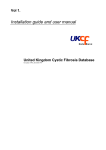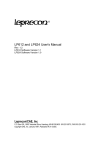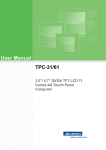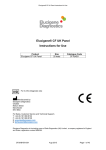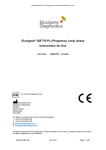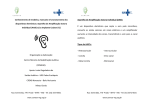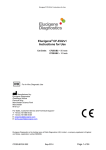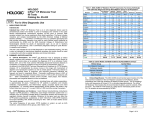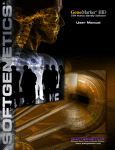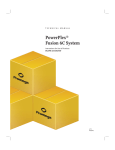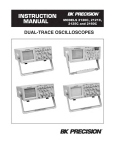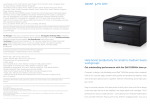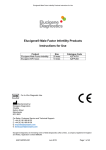Download Elucigene® CF Iberian Panel Instructions for Use
Transcript
Elucigene® CF Iberian Panel Products Instructions for Use Elucigene® CF Iberian Panel Instructions for Use Product Elucigene CF Iberian Panel Size 25 tests Catalogue Code CFIBNB1 For In-Vitro Diagnostic Use Manufactured by: Elucigene Diagnostics Citylabs Nelson Street Manchester M13 9NQ For Sales, Customer Service and Technical Support:T: +44 (0) 161 669 8122 F: +44 (0) 161 669 8129 E: [email protected] E: [email protected] Elucigene Diagnostics is the trading name of Delta Diagnostics (UK) Limited., a company registered in England and Wales, registration number 8696299. CFIBNBYEN 001 Jun-2015 Page 1 of 42 Elucigene® CF Iberian Panel Products Instructions for Use Elucigene CF Iberian Panel Intended Use For the simultaneous detection of the following human Cystic Fibrosis Transmembrane conductance Regulator (CFTR) gene mutations in DNA extracted from whole blood (EDTA preserved) :Legacy Name HGVS Nomenclature* Intron/Exon cDNA name Protein name Legacy Intron/Exon Intron/Exon 712-1G>T c.580-1G>T Protein name - Intron 5 Intron 5 H199Y c.595C>T p.His199Tyr Exon 6a Exon 6 P205S c.613C>T p.Pro205Ser Exon 6a Exon 6 V232D c.695T>A p.Val232Asp Exon 6a Exon 6 1609delCA c.1477_1478delCA p.Gln493ValfsX10 Exon 10 Exon 11 1812-1G>A c.1680-1G>A - Intron 11 Intron 12 A561E c.1682C>A p.Ala561Glu Exon 12 Exon 13 2184insA c.2052_2053insA p.Gln685ThrfsX4 Exon 13 Exon 14 R709X c.2125C>T p.Arg709X Exon 13 Exon 14 K710X c.2128A>T p.Lys710X Exon 13 Exon 14 2869insG c.2737_2738insG p.Tyr913X Exon 15 Exon 17 A1006E c.3017C>A p.Ala1006Glu Exon 17a Exon 19 * with reference to – Mutation Nomenclature in Practice: Findings and Recommendations from the Cystic Fibrosis External Quality Assessment Scheme. Berwouts S, Morris M, Girodon G, Schwarz M, Stuhrmann M and Dequeker E. Human Mutation, Vol.00, No. 0, 1-7 (2011) The Elucigene CF Iberian Panel can distinguish between individuals who are heterozygous and homozygous for the all the above mutations and variants. CFIBNBYEN 001 Jun-2015 Page 2 of 42 Elucigene® CF Iberian Panel Products Instructions for Use Summary and Explanation Cystic Fibrosis (CF) is the most common life-limiting autosomal recessive disorder in the Caucasian population. The disease incidence is 1:3200 live births among Caucasians (1). In the Caucasian population, the heterozygote frequency is approximately 1:25. Cystic fibrosis affects the epithelia in several organs resulting in a complex, multisystem disease that includes the exocrine pancreas, intestine, respiratory tract, male genital tract, hepatobiliary system, and exocrine sweat glands. Disease expression varies by severity of CFTR mutations (2), genetic modifiers (3), and environmental factors (4). The range extends from early childhood death as a result of progressive obstructive lung disease with bronchiectasis, to pancreatic insufficiency with gradually progressive obstructive lung disease during adolescence and increasing frequency of hospitalisation for pulmonary disease in early adulthood, to recurrent sinusitis and bronchitis or male infertility in young adulthood. Most commonly the diagnosis of cystic fibrosis is established in individuals with one or more characteristic phenotypic features of CF plus evidence of an abnormality in CFTR function based on one of the following: presence of two disease-causing mutations in the CFTR gene or two abnormal quantitative pilocarpine iontophoresis sweat chloride values (>60 mEq/L) or transepithelial nasal potential difference (NPD) measurements characteristic of CF. The CFTR mutation detection rate varies by test method and ethnic background. In some symptomatic individuals, only one or neither disease-causing mutation is detectable; in some carriers, the disease-causing mutation is not detectable. CFTR-related disorders are inherited in an autosomal recessive manner. Siblings of a proband with cystic fibrosis have a 25% chance of being affected, a 50% chance of being asymptomatic carriers, and a 25% chance of being unaffected and not carriers. Molecular genetic testing for disease-causing mutation(s) in the CFTR gene is used for carrier detection in population screening programs. Prenatal testing is available for pregnancies at increased risk for CFTR-related disorders if the disease-causing mutations in the family are known. Since the discovery of the CFTR gene in 1989 (5), more than 1700 mutations and variants in the gene have been described (6). Many of these mutations are ‘private’, having been described only in one patient and/or family. Routine testing for all possible mutations is neither feasible nor cost effective and is therefore confined to testing for the most common mutations. The Elucigene CF Iberian panel is designed to extend the coverage of Elucigene CF-EU2v1 specifically to address the most common mutations found in Spanish and Portuguese populations. The Elucigene CF Iberian panel identifies 12 additional mutations in total. CFIBNBYEN 001 Jun-2015 Page 3 of 42 Elucigene® CF Iberian Panel Products Instructions for Use Principles of the procedure The method employed by the Elucigene CF Iberian Panel uses fluorescent ARMS (Amplification Refractory Mutation System) allele specific amplification technology, which detects point mutations, insertions or deletions in DNA (7). The principle of ARMS is that oligonucleotides with a 3’ mismatched residue will not function as Polymerase Chain Reaction (PCR) primers under specified conditions. Selection of appropriate oligonucleotides allows specific mutant or normal DNA sequences to be amplified and detected. Amplified sequences (amplicons) are separated by capillary electrophoresis using an Applied Biosystems Genetic Analyzer instrument. Analysis software enables amplicons to be identified and labelled according to their size and dye colour. Elucigene CF Iberian Panel is a multiplexed assay comprising a single PCR. In a single reaction mix both mutant and wild type alleles are detected for twelve mutations within the CFTR gene. In the CF Iberian Panel assay, mutant alleles are visualised as blue amplicon peaks and wild type alleles are visualised as green amplicon peaks. The internal amplification control markers (non-cystic fibrosis) found in CF-EU2v1 are also included in the CF Iberian Panel mix. These are visualised as red amplicon peaks and are used to monitor the efficiency of sample amplification and aid patient identification when running the CF Iberian Panel alongside the Elucigene CF-EU2v1 assay. CFIBNBYEN 001 Jun-2015 Page 4 of 42 Elucigene® CF Iberian Panel Products Instructions for Use Warnings and Precautions 1. The normal DNA Control provided in the kits has been independently tested and found to be negative for Hepatitis B Virus (HBV), Hepatitis C Virus (HCV) and Human Immunodeficiency Virus (HIV) 1 and 2. 2. Care should be taken when handling material of human origin. All samples should be considered potentially infectious. No test method can offer complete assurance that HBV, HCV, HIV or other infectious agents are absent. 3. Handling of samples and test components, their use, storage and disposal should be in accordance with the procedures defined by the appropriate national biohazard safety guideline or regulation. 4. In line with current good laboratory practice, laboratories should process their own internal QC samples of known type in each assay, so that the validity of the procedure can be assessed. 5. If kit box is damaged, there may be damage to the contents, do not use the kit, contact Customer Service. CFIBNBYEN 001 Jun-2015 Page 5 of 42 Elucigene® CF Iberian Panel Products Instructions for Use Symbols used on labels The symbols used on all labels and packaging conform to the harmonised standard ISO 15223 Manufacturer Number of tests See Instructions for Use X°C Store below temperature shown Use before date shown Catalogue code Lot or batch number In Vitro Diagnostic Medical Device CFIBNBYEN 001 Jun-2015 Page 6 of 42 Elucigene® CF Iberian Panel Products Instructions for Use Materials Provided Each kit contains: Elucigene CF Iberian Panel (TA) (Part Code 450215): 1 x 120µl (25 tests), Primer Mix containing primers to amplify the following wild-type and mutant alleles A1006E, 1812-1G>A, A561E, 1069delCA, 2869insG, K710X, R709X, 2184insA, 712-1G>T, H199Y, P205S, and V232D. This mix also contains primers for identification of 2 hypervariable short tandem repeat (STR) markers. PCR Master Mix (TM) (Part Code: 404480): 1 x 400l vial of containing HotStart Taq DNA Polymerase and deoxynucleotide triphosphates in buffer. DNA Control (DC) (Part Code 40448): 1 x 50µl vial DNA Control at 6ng/l, normal for the mutations detected by Elucigene CF Iberian Panel. Kit Preparation and Storage Storage of the reagents should be in an area free from contaminating DNA or PCR product. Store all components below -20°C in the dark. The fluorescent dyes used in this product are photosensitive, minimise exposure to light. CFIBNBYEN 001 Jun-2015 Page 7 of 42 Elucigene® CF Iberian Panel Products Instructions for Use Materials required but not provided General Laboratory consumables – gloves; screw-capped microfuge tubes; 0.2ml PCR vials or microtitre plates recommended by the manufacturer of the thermal cycler used; pipette tips. Laboratory equipment – precision pipettes (2 sets: 1 for pre-amplification and 1 for post-amplification handling; preferably positive displacement pipettes); protective clothing; vortex mixer; microfuge; 96well microtitre plate centrifuge. PCR Amplification Thermal cycler to accommodate 96-well microtitre plates or 0.2ml vials with a temperature accuracy of +/-1°C between 33°C and 100°C and static temperature uniformity of +/-1°C. CF Iberian Panel has been validated and shown to perform to specification on the following recommended Thermal Cycler platforms: Applied Biosystems GeneAmp 9700 Applied Biosystems Veriti Dx (Running in Standard mode) Applied Biosystems Veriti Dx (Running in 9700-simulation mode) Applied Biosystems Proflex (Running in Standard mode) Note: Thermal cycler equipment should be regularly maintained, in accordance with the manufacturer’s instructions, and calibrated to ensure accurate PCR cycling and optimal performance. The Elucigene CF Iberian assay was developed on Applied Biosystems Veriti thermal cycler (in 9700 mode). Other makes and models should be fully tested and evaluated for optimal performance by the user before reporting results with CF Iberian Panel. Capillary Electrophoresis Capillary Electrophoresis –POP-7 Polymer (ABI Cat No 4352759), 10x Genetic Analyzer Buffer (ABI Cat No 402824) and Hi-Di Formamide (ABI Cat No 4311320), GeneScan 600v2 LIZ size standard (ABI Cat No 4408399) and DS-33 (dye set G5) matrix standard (ABI Cat No 4345833). Applied Biosystems ABI 3130 and 3500 Genetic Analyzers (with GeneMapper software), 36cm capillary array (50cm capillary array for 3500 Genetic Analyzer), 96-well optical plates, 96-well septa, 96-well cassettes. Data Analysis One of the following data analysis software packages is required: GeneMapper 3.7 (Applied Biosystems Inc.) or above or GeneMarker 1.65 (SoftGenetics LLC) or above. CFIBNBYEN 001 Jun-2015 Page 8 of 42 Elucigene® CF Iberian Panel Products Instructions for Use Sample Collection and Storage DNA extracted from whole blood (EDTA) samples have been evaluated to be compatible with this test. Sample collection devices have on occasion been reported to be detrimental to the integrity of certain analytes and could interfere with some method technologies (8). It is recommended that each user ensure that the chosen device is used according to the manufacturer’s instructions and sample collection devices are compatible with this test. Blood samples should be stored at -20°C prior to preparation of DNA. Avoid repeated freezing and thawing. Preparation of DNA from Whole Blood (EDTA) Samples Results are consistently obtained with DNA extracted using the QIAamp 96 DNA Blood Kit (or the QIAamp DNA Mini Kit using Proteinase K) following the protocol as described in the QIAamp Handbook starting with 200l liquid whole blood and eluting in 200l of molecular biology grade water. DNA Concentration Using the recommended PCR conditions and sample injection settings (see note in Capillary Electrophoresis section) stated in the capillary column run modules, acceptable results are consistently obtained with input DNA amount of 15ng. However interpretable results are obtained with an input DNA range of 5ng to 30ng. The quantification of DNA is very important, the concentration of every DNA sample to be tested should be measured to ensure optimal results. Techniques such as PicoGreen fluorescence or UV absorbance are acceptable. Due to variation in DNA quantification techniques the user should consider the following guidance: Very high input DNA amounts will increase the likelihood that background peaks are labelled by the analysis software. The following steps can be taken to reduce the likelihood that background peaks are labelled. Dilute DNA sample and re-amplify. Reduce injection time – see Capillary Electrophoresis section. Increase minimum peak amplitude threshold Low input DNA amounts will increase the likelihood that diagnostic peaks are weak and not labelled by the analysis software. The following steps can be taken to increase signal. Increase injection time - see Capillary Electrophoresis section. Re-extract sample and elute in reduced volume (50l) of water. CFIBNBYEN 001 Jun-2015 Page 9 of 42 Elucigene® CF Iberian Panel Products Instructions for Use Test Protocol Amplification Procedure Note: to minimise the risk of contamination, steps 3 - 5 must be carried out in an area free from DNA. Steps should also be taken to avoid contamination with PCR product. 1. Program the thermal cycler for a single step cycle to activate the DNA polymerase at 94°C for 20 minutes linked to an amplification cycling program of 1 minute at 94°C (denaturation), 2 minutes at 58°C (annealing) and 1 minute at 72°C (extension) for 30 cycles. This should be linked to a 20 minutes time-delay file at 72°C (extension) on the final cycle. 2. A negative (water) control must be included in each PCR run. It may also be considered appropriate to include other controls, e.g. positive control (DNA control supplied). 3. Thaw the Primer Mix and the PCR Master Mix and centrifuge briefly to collect the contents at the bottom of the vials. Mix gently by vortexing and briefly centrifuge the vials again. Prepare sufficient Reaction Mix for the number of samples and controls to be tested (Table 1). Note: The PCR Master Mix is viscous and care should be taken to ensure that the correct volumes are handled. It is recommended that the PCR Master Mix be added to the previously dispensed primer mixes to ensure all liquid is dispensed from the pipette into the Primer Mix. Note: Do not use different mixes or components from different lots of CF Iberian Panel kit CFIBNBYEN 001 Jun-2015 Page 10 of 42 Elucigene® CF Iberian Panel Products Instructions for Use Table 1: Reaction Mix Formulation Number of Samples to be Tested 1 10 25 50 Primer Mix (μl) 4.5 45 112.5 225 PCR Master Mix (μl) 7.5 75 187.5 375 Total (μl) 12 120 300 600 4. Dispense 10μl of each reaction mix into the bottom of the appropriately labelled 0.2ml PCR vials or plates. 5. Using separate pipette tips add 2.5μl of test DNA sample to each of the vials and cap. Do not add DNA to the vial for the negative control, substitute with 2.5µl of sterile deionised water. 6. Briefly centrifuge the vials until all liquid is at the bottom of each vial. 7. Place all vials firmly in the thermal cycler block. Initiate the 94°C activation program followed by the amplification program (see step 1). 8. On completion of the amplification program the samples may be stored at room temperature overnight or at 2-8°C for up to 7 days before analysis by capillary electrophoresis. CFIBNBYEN 001 Jun-2015 Page 11 of 42 Elucigene® CF Iberian Panel Products Instructions for Use Capillary Electrophoresis It is recommended that each user ensure that the chosen equipment is used according to the manufacturer’s instructions and is compatible with this test. In this context the key parameters are the polymer and the capillary array. Optimal results can be obtained using the following capillary electrophoresis conditions on an ABI3130 or ABI3500 Genetic Analyzer. 1. Combine 6.8µl of size standard with 250µl Hi-Di Formamide and mix thoroughly (sufficient mix for 16 wells). Dispense 15µl of the mix into the required number of wells of a 96 well optical plate*. 2. Add 3µl of test sample PCR product to the size standard mix (from step 1) already dispensed into the plate and mix using the pipette. Seal the plate. 3. Denature the PCR product dispensed into the optical plate on a thermal cycler using the following parameters: 94°C for 3 minutes linked to 4°C for 30 seconds. 4. Centrifuge the plate at 1,000g for 10 seconds to remove any bubbles in the wells and load onto the Genetic Analyzer. *Note: It is essential that unused wells (i.e. wells in which No DNA sample is loaded) are still loaded with Hi-Di Formamide to ensure that the capillaries do not dry out. Sample injection settings can be modified to suit the amount of amplicon produced during the PCR which can vary due to amount of input genomic DNA added. Less amplicon can be applied to the column for analysis by reducing time of injection. Conversely more amplicon can be applied to the column for analysis by increasing time of injection. Previously amplified samples can be re-injected multiple times for re-analysis. Post-PCR Data Analysis ABI3130 GENETIC ANALYZER The CF Iberian Panel has been designed to be compatible with the Elucigene CFEU2v1 product. As such, CF Iberian Panel can be run using existing CFEU2v1 Run Modules and settings. Alternatively, a separate CF Iberian Panel Run Module can be created by the user as follows. Create a sample sheet using the 3130 data collection software with the following settings: • Sample Name: this must be the same sample specific name or number. • Run owner: select the default owner for lab. • Run Protocol: CF_Iberian (contains 3130 run module)*. *Note: It is necessary to create a run module detailing the instrument settings and subsequently assign this to a Run protocol in which Dye set G5 has been selected. For more information on creating run modules please refer to your instrument user manual. CFIBNBYEN 001 Jun-2015 Page 12 of 42 Elucigene® CF Iberian Panel Products Instructions for Use 3130 RUN MODULE FOR POP7 POLYMER 36cm Capillary Module: MFI Create the CF Iberian run module in the Module Manager of the 3130 data collection software. Ensure the following are selected: • Type: Regular • Template: FragmentAnalysis36_POP7 • Enter the settings detailed in the table below: # Parameter Name Value 1 2 3 4 5 6 7 8 9 10 11 12 Oven Temperature Poly_fill_Vol. Current Stability PreRun_Voltage Pre_Run_Time Injection_Voltage Injection_Time Voltage_Number_of_Steps Voltage_Step_Interval Data_Delay_Time Run_Voltage Run_Time 60 6500 5.0 15.0 180 3.0 12.0 20 15 60 15.0 1200 Range int 18…65 Deg.C 6500…38000 steps int 0…2000 uAmps 0…15 kvolts 1…1000 sec. 1…15 kvolts 1…600 sec. 1…100 nk 1…60 sec. 1…3600 sec. 0…15 kvolts 300…14000 sec. Note: Required ‘run time’ will vary dependent on the ambient temperature of the location in which the Genetic Analyzer has been installed. For more information on creating run modules please refer to the Applied Biosystems 3130 Genetic Analyzer User Manual. Create the CF Iberian Panel protocol in the Protocol Manager, ensure the following are selected: • Type: Regular • Run Module: CF_Iberian (see run module above) • Dye Set: G5 To run the samples create a sample sheet using the Plate Manager, ensure the correct protocol has been selected for the instrument protocol (see above). Note: For more information on instrument setup, operation and troubleshooting please refer to the Applied Biosystems 3130 Genetic Analyzer User Manual. CFIBNBYEN 001 Jun-2015 Page 13 of 42 Elucigene® CF Iberian Panel Products Instructions for Use ABI3500 GENETIC ANALYZER An Instrument Protocol needs to be created which can then be used for both the CF Iberian Panel and CF-EU2v1. Create the Instrument Protocol through the 3500 Instrument Protocols library. Ensure the following are selected: • Run Module: FragmentAnalysis50_POP7 • Enter the settings detailed in the image below: To run the samples create a sample plate by clicking on ‘Create Plate from Template’ in the ‘Dashboard’, ensure the correct Instrument Protocol has been assigned (see above). CFIBNBYEN 001 Jun-2015 Page 14 of 42 Elucigene® CF Iberian Panel Products Instructions for Use Analysis and Interpretation of Results General Interpretation of Results PCR products are observed as a 5 dye labelled system using filter set G5. Filter set G5 detects the 6FAM (blue), VIC (green), NED (yellow) and PET (red) labelled fragments plus the Size Standard marker labelled with LIZ (orange) on an electrophoretogram and in the GeneMapper or GeneMarker program. Important Note: different combinations of instrument, polymer and size standard may cause the size calling to vary slightly. During validation of the kit, users should check that the default bin settings result in accurate peak labelling and adjust if necessary. In case of any difficulty, please contact Technical Support ([email protected]) for advice. CFIBNBYEN 001 Jun-2015 Page 15 of 42 Elucigene® CF Iberian Panel Products Instructions for Use General analysis guide for CF Iberian Panel In the CF Iberian Panel both mutant specific and wild type specific primers are combined in the same mix. The presence of a CF mutation is identified by the presence of a blue peak and the presence of a wild type (normal) allele is identified by the presence of a green peak. Individuals who carry both a mutant copy and a wild type copy (heterozygote) of a specific allele will show both a blue and a green peak for that allele. Individuals who carry two mutant copies of a specific allele (homozygous mutant) will show a single blue peak for that allele. Individuals who carry two wild type copies of a specific allele (homozygous wild type) will show a single green peak for that allele. Hypervariable STR markers (red) are also included in this mix. These STR markers are the same as those included in the CF-EU2v1 A and B mixes which enables the comparison between patient samples amplified with both the CF Iberian Panel and CF-EU2v1 A and B mixes. This helps to reduce the potential for sample mix up as a different STR profile in any of the three mixes indicates a sample mix up. Absence of these STR markers indicates a failed sample. Presence of the STR markers at very low rfus indicates a weak sample which should be analysed with caution. Markers Detected The table below summarises the markers detected by CF Iberian Panel mix. Markers are listed according to the size range of PCR product observed. Markers Detected Marker (Peak No.) 01 02 03 04 05 06 07 08 09 10 11 12 Marker A1006E 1812-1G>A A561E 1609delCA 2869insG K710X R709X 2184insA 712-1G>T H199Y P205S V232D Product bp Size Range (3130/POP7 data) 145-154 175-182.5 183-191 198-213 228-233 261-268 270-277 332-338 383-395 400-408 415-423 496-505 Note: Marker sizes may vary due to the instrument and polymer used. CFIBNBYEN 001 Jun-2015 Page 16 of 42 Elucigene® CF Iberian Panel Products Instructions for Use Examples of Interpretation Normal Result In a normal result all alleles detected are homozygous wild type which is indicated by the presence of labelled single green peaks for all 12 markers. The STR markers should be unlabelled and the marker sizes/pattern should be concordant with the marker sizes/pattern of the CF-EU2v1 A and B mixes for a given sample. An example of a normal result is shown below. Heterozygous Mutation The example below shows an 1812-1G>A heterozygote. The mutant 1812-1G>A allele is indicated by the labelled blue peak to the left of the wild type A1006E allele (labelled green peak). In all cases the mutant (blue) peaks should be located to the left of the wild type (green) peaks. Compound Heterozygote The example below shows a compound heterozygote result for mutations P205S and V232D. Both mutant P205S and V232D alleles are indicated by the labelled blue peaks to the left of their respective wild type allele peaks (labelled green peak). CFIBNBYEN 001 Jun-2015 Page 17 of 42 Elucigene® CF Iberian Panel Products Instructions for Use Insertions and Deletions Due to the nature of the design of the Elucigene CF Iberian Panel the presence of insertions or deletions between two opposing primers will result in size changes to all of the amplicons produced between these two primers. Therefore in addition to the 12 mutations detected by the CF Iberian Panel, any insertions and deletions within the amplified target sequences can be detected by the change in expected amplicon size of the wild type (green) peaks. These have been described in the Table of Insertions and Deletions which is available from the Elucigene website: http://www.elucigene.com/product-category/cystic-fibrosis/ 2347delG is an example of a deletion detected by the Elucigene CF-EU2v1 assay which impacts the exon 14 wild type (green) peaks of the CF Iberian assay profile as demonstrated below: 2347delG Two peaks 1bp apart are observed for CF Iberian wild type (green) peak 6 (K710X), peak 7 (R709X) and peak 8 (2184insA) in an individual heterozygous for the 2347delG mutation (see profile below). The presence of the 2347delG mutation will be confirmed if using the CF-EU2v1 assay (shown as a blue peak at position 16 in the A mix of CF-EU2v1). Other Observations H199Y and P205S Interaction The P205S mutation has been identified to partially interfere with amplification of H199Y wild type primer sequence. Reduced height of the wild type peak 10 (H199Y) may be observed in an individual heterozygous for the P205S mutation. CFIBNBYEN 001 Jun-2015 Page 18 of 42 Elucigene® CF Iberian Panel Products Instructions for Use Cross Reactivity Every effort has been taken during test development to avoid interference of test function by the presence of other reported polymorphisms and mutations in the CFTR gene. Evaluation of known mutations and polymorphisms in the CFTR gene has highlighted the following effects on the Elucigene CF Iberian Panel results: 2184delA The 2184insA mutant primer will detect the 2184delA mutation. Both 2184insA and 2184delA mutations are distinguishable based on an amplicon size difference of 2bp. The distinction between these mutations is shown in diagrams A and B below: A) B) A) 2184insA mutant amplicon is the same size as the wild-type amplicon and is presented as a labelled blue peak significantly overlapping the wild type peak as shown above. B) 2184delA mutant amplicon is 2bp smaller than the wild type amplicon and is presented as an unlabeled blue peak which falls outside the bin range of the 2184insA panel. CFIBNBYEN 001 Jun-2015 Page 19 of 42 Elucigene® CF Iberian Panel Products Instructions for Use 2183AA>G The 2184insA wild-type primer will not amplify alleles containing the 2183AA>G mutation resulting in drop out of the wild-type 2184insA peak. The example below shows the 2184insA wild-type peak at half intensity in the presence of a 2183AA>G heterozygote. Note: In the presence of a 2183AA>G homozygote, it is expected that the 2184insA wild-type peak would drop out completely due to no amplification of either allele. Should this occur follow up studies to test for the presence of 2183AA>G is recommended. The following mutations, which have not been checked for possible cross reactivity due to unavailability of relevant samples, may interfere with test function: G194R, G194V, H199R, H199Q, P205R, L233F, Q493X, Q493P, Q493R, 1612delTT, R560S, 1813insC, R709Q, 2868G>A, S912L, S912X, I1005R. This list is neither exclusive nor exhaustive. CFIBNBYEN 001 Jun-2015 Page 20 of 42 Elucigene® CF Iberian Panel Products Instructions for Use GeneMapper Software Analysis Guide Introduction The following section describes the procedures for sample analysis of Elucigene CF-Iberian Panel results using Applied Biosystems GeneMapper software packages (version 3.7 or greater). Note: screenshots in this document are taken from GeneMapper v5. Analysis Process The process for analysis of samples is summarised in the flow diagram shown below: Run Amplified Samples on Genetic Analyzer Open GeneMapper Software Add Sample FSA Files to Project Select Appropriate Analysis Method, Panel & Size Standard Run Sample Analysis Save GeneMapper Project Select Sample & Open Plot Window Review Trace & Genotype Data Score Sample Genotypes Print Elucigene CF Iberian Panel Sample Traces CFIBNBYEN 001 Jun-2015 Page 21 of 42 Elucigene® CF Iberian Panel Products Instructions for Use Importing CF Iberian Panel GeneMapper Analysis Settings Before first use of the kit it is necessary to import the CF Iberian Panel settings for GeneMapper. This process is controlled through the ‘GeneMapper Manager’ interface. CF Iberian Panel GeneMapper settings are available from the Elucigene website: http://www.elucigene.com/product-category/cystic-fibrosis/ 1. Open ‘GeneMapper Manager’ by clicking on the icon (Figure 1). Figure 1: Opening GeneMapper Manager 2. Select the ‘Analysis Methods’ tab and then click the import button (Figure 2). Figure 2: GeneMapper Manager Interface CFIBNBYEN 001 Jun-2015 Page 22 of 42 Elucigene® CF Iberian Panel Products Instructions for Use 3. Navigate to and import the CF Iberian Panel Analysis Method (3130 or 3500) (Figure 3). Figure 3: Importing Analysis Methods 4. Repeat the process, selecting the appropriate tab and importing the corresponding file for: Table Settings Plot Settings Size Standard Note: Table Settings, Plot Settings and Size Standard are the same as used in CF-EU2v1. Operators currently using CF-EU2v1 can apply these settings without importing. CFIBNBYEN 001 Jun-2015 Page 23 of 42 Elucigene® CF Iberian Panel Products Instructions for Use Importing CF Iberian Product Bin and Panel Files in Panel Manager Before first use of the kit it is necessary to import the CF Iberian product bin and panel files for GeneMapper. This process is controlled through the ‘Panel Manager’ interface. CF Iberian GeneMapper bin and panel files are available from the Elucigene website: http://www.elucigene.com/product-category/cystic-fibrosis/ 1. Open Panel Manager Program by clicking on the icon. 2. Click ‘Panel Manager’ on the left navigation window. The Panel Manager will now appear highlighted in blue. 3. Select ‘File/Import Panels’. Navigate to and import the GeneMapper panel ‘CF Iberian GeneMapper Panel File.txt’ 4. The panel file will now be displayed on the left navigation window. Click on the panel file ensuring that it is highlighted blue. 5. Select ‘File/Import Bin Set’. Navigate to and import the GeneMapper bin file ‘CF Iberian GeneMapper Bin File.txt’ (Figure 5). 6. Click ‘Apply’ then click ‘OK’. Figure 4: Importing CF Iberian panel file CFIBNBYEN 001 Jun-2015 Page 24 of 42 Elucigene® CF Iberian Panel Products Instructions for Use Figure 5: Importing CF Iberian bin file CFIBNBYEN 001 Jun-2015 Page 25 of 42 Elucigene® CF Iberian Panel Products Instructions for Use Importing CF Iberian Panel Raw Data Files into GeneMapper 1. Open the GeneMapper Program file. 2. Click in order to add data files to a new project. Navigate to where the raw .fsa data files are stored, highlight the appropriate data files and click the ‘Add to List>>’ button. 3. The run folder will now appear in the ‘Samples to Add’ window. Double clicking on the run folder icon in this window will show each .fsa file to be imported. Samples are then added by clicking at the bottom of the screen. The data files now appear within the GeneMapper main screen (Figure 6) Figure 6: Samples have been added to list and are ready to add to project. CFIBNBYEN 001 Jun-2015 Page 26 of 42 Elucigene® CF Iberian Panel Products Instructions for Use Raw Data Files 1. In the main GeneMapper window select the ‘CFEU2 Table Settings’ as shown (Figure 7). Figure 7: Selecting table settings 2. In the main GeneMapper window select the first cell under the ‘Analysis Method’ and select the appropriate analysis method from the drop down menu: CF Iberian Panel Analysis Method (either 3130 or 3500). 3. Repeat this process for the ‘Panel’, by selecting the ‘CF Iberian Panel’ and similarly for the ‘Size Standard’, by selecting ‘CFEU2 size standard’ from the drop down menus. 4. Click to initiate sample analysis. Assign a project name when prompted. CFIBNBYEN 001 Jun-2015 Page 27 of 42 Elucigene® CF Iberian Panel Products Instructions for Use Reviewing 1. Select the sample for analysis (highlight sample row). 2. Click to ‘Display Plots’. 3. Use the drop down menu to select the appropriate CF-EU2v1 Plot settings (Figure 8). Note: if analysing CF Iberian Panel data alongside CF-EU2v1 data, the CF Iberian Panel is compatible with both CFEU2v1 Plot PT-on and CFEU2v1 Plot PT-off settings. Figure 8: Use the drop down menu to select CFEU2 Plot Settings 4. The plot window will display sample trace data (Figure 9). 5. It is recommended that the plot window has ‘Single click editing’ activated. To do this select ‘Alleles/set click editing’ and ensure that this option is checked. Figure 9: CF Iberian Panel Sample Plot window displaying labelled trace data CFIBNBYEN 001 Jun-2015 Page 28 of 42 Elucigene® CF Iberian Panel Products Instructions for Use Modifying the Analysis Parameter file It may be necessary to modify the default ‘Analysis Ranges’ in the CF Iberian Panel Analysis Method settings in order to account for your in-run conditions. The minimum analysis range will depend on the capillary and polymer being used during data collection. To view current analysis settings: 1. Open ‘GeneMapper Manager’ by clicking on the icon. 2. Select the ‘Analysis Methods’ tab. The Imported CF Iberian Panel file will be listed as ‘CF Iberian Panel Analysis Method’. 3. Click on ‘CF Iberian Panel Analysis Method. The row will now appear highlighted. 4. Click the ‘Open’ button and select the ‘Peak Detector’ tab (Figure 10). Figure 10: Analysis Ranges CFIBNBYEN 001 Jun-2015 Page 29 of 42 Elucigene® CF Iberian Panel Products Instructions for Use To find the correct analysis range for your laboratory: 1. From the main GeneMapper window, double click on the imported Run Folder to view the list of .fsa files it contains. 2. Select an .fsa file. 3. Clicking the ‘Raw data’ tab will display the electropherogram of the raw data. 4. Using the 100bp GS600v2 LIZ peak (Orange) as a guide, decide on a data point approximately 100 data points smaller (Figure 11). 5. Ensure the maximum analysis range encompasses the largest peak of the size standard (600bp for GS600LIZv2). 6. Input the new values into the Analysis file (accessing it as described above). Figure 11: Finding the minimum range using sample raw data CFIBNBYEN 001 Jun-2015 Page 30 of 42 Elucigene® CF Iberian Panel Products Instructions for Use GeneMarker Analysis Guide Introduction The following section describes the procedures for sample analysis of Elucigene CF-Iberian Panel results using SoftGenetics GeneMarker software package (version 1.95 or greater). Note: screenshots in this document are taken from GeneMarker v 2.6.3. Analysis Process The process for analysis of samples is summarised in the flow diagram shown below: Run Amplified Samples on Genetic Analyzer Open GeneMarker Software Add Sample FSA Files to Project Select Relevant CF Iberian Panel & Confirm Analysis Settings Run Sample Analysis Select the Application: ARMS/Comparative Analysis Select Print Select Preview CFIBNBYEN 001 Jun-2015 Page 31 of 42 Elucigene® CF Iberian Panel Products Instructions for Use Adding Sample Files to GeneMarker Open the GeneMarker program file and when prompted, select ‘Open Data’. The Open Data Files box will appear. Click the ‘Add’ button. The Open dialog will appear. Navigate to directory containing raw data files; 1. Select all files by CTRL+A or use CTRL and/or SHIFT keys to select individual samples. 2. Click ‘Open’ button in the Open dialog. The files selected will appear in the Data File List field (Figure 12). Figure 12: Samples added to the Data File list. 3. Click ‘OK’ button in the Open Data Files box and the samples will be uploaded to GeneMarker. The software will then automatically open the Raw Data Analysis window (Figure 13). CFIBNBYEN 001 Jun-2015 Page 32 of 42 Elucigene® CF Iberian Panel Products Instructions for Use Figure 13: Raw Data Analysis Window CFIBNBYEN 001 Jun-2015 Page 33 of 42 Elucigene® CF Iberian Panel Products Instructions for Use Importing CF Iberian Panel GeneMarker Panel Settings Before first use of the kit it is necessary to import the CF Iberian panel file for GeneMarker. This process is controlled through the ‘Panel Editor’ interface. The CF Iberian Panel GeneMarker panel file are available from the Elucigene Website: http://www.elucigene.com/product-category/cystic-fibrosis/ 1. Open ‘Panel Editor’ from the ‘Tools’ drop-down menu (Figure 14). Figure 14: Selecting Panel Editor 2. Select ‘Import Panels’ from the ‘File’ drop-down menu (Figure 15) Figure 15: Importing Panels 3. Navigate to and import the panel ‘CF Iberian Panel GeneMarker Panel File.xml’. 4. Repeat the process as required for other relevant panel files. CFIBNBYEN 001 Jun-2015 Page 34 of 42 Elucigene® CF Iberian Panel Products Instructions for Use Importing CF Iberian Panel GeneMarker Size Standard Settings Before first use of the kit it is necessary to import the appropriate size standard file for GeneMarker. This process is controlled through the ‘Size Template Editor’ interface. The CF Iberian Panel GeneMarker size standard file is available from the Elucigene Website: http://www.elucigene.com/product-category/cystic-fibrosis/ 5. For the Size Standard File open ‘Size Template Editor’ from the ‘Tools’ drop down menu. 6. Select ‘Size Standard’ from the ‘File’ drop-down menu. 7. Navigate to and import the CF Iberian Panel Size Standard file CF Iberian Panel GeneMarker Size Standard.xml. Processing Data After the raw data files have been uploaded to GeneMarker, they are ready to be processed. The processing step includes application of a sizing standard, filtering of noisy peaks, and comparison to a known allelic panel if desired. GeneMarker combines all these steps in one simple tool called the ‘Run Wizard’ (Figure 16). To access the Run Wizard simply click the ‘Run Project’ icon in the main toolbar. Run Wizard – creating a Run Template It is necessary to create a run template the first time this software is used to analyse CF Iberian Panel data. This is done through the Run Wizard; 1. To access the Run Wizard simply click on the ‘Run Project’ icon in the main toolbar. 2. Assign a Template Name e.g. CF Iberian 3. Select the Panel, Size Standard, Standard Colour and Analysis Type as shown in Figure 16 below. 4. Click ‘Save’ to store the template for future analyses. 5. Click ‘Next’ to continue. CFIBNBYEN 001 Jun-2015 Page 35 of 42 Elucigene® CF Iberian Panel Products Instructions for Use Figure 16: Run Wizard – Template Selection Window CFIBNBYEN 001 Jun-2015 Page 36 of 42 Elucigene® CF Iberian Panel Products Instructions for Use Run Wizard – Data Process The Data Process window of Run Wizard allows the user to select the peak filtering parameters. 1. Select the appropriate analysis settings in the Data Process window as shown in the figure below (Figure 17). 2. Click ‘Next’ to continue Note: The analysis range setting within the raw data analysis bow will vary depending on the Polymer used during data collection. The operator should select a start data point value that includes the 60bp size standard peak. Figure 17: Run Wizard – Data Process Window Note: For 3500 data, increase the Minimum Intensity to 150 CFIBNBYEN 001 Jun-2015 Page 37 of 42 Elucigene® CF Iberian Panel Products Instructions for Use Run Wizard – Additional Settings There are no additional settings required (Figure 18). 1. Click ‘OK’ to continue. Figure 18: Run Wizard – Additional Settings Data Processing Box After clicking ‘OK’ in the Run Wizard Additional Settings box, the Data Processing box appears (Figure 19). The raw data is processed and sized, then the filtering parameters and the selected Panel are applied. 1. Click ‘OK’ in the Data Processing box when analysis is complete. Figure 19: Data Processing Box CFIBNBYEN 001 Jun-2015 Page 38 of 42 Elucigene® CF Iberian Panel Products Instructions for Use Main Analysis Window The Main Analysis window (Figure 20) of GeneMarker has an easy to use layout. This layout includes: The sample files list - displayed on the left side of the window. The Synthetic Gel Image - displayed at the top of the window. Data Electropherograms - below the gel image. A Report Table - displayed on the right side of the window. In this window it is important to check that all the appropriate peaks in each profile have been called correctly. Double-click on each sample in turn in the sample file tree on the left-hand side of the screen. Right-click on any peaks in question and choose from the options in the dialogue box e.g. edit or delete allele, confirm or unconfirm as appropriate. Figure 20: Main Analysis Window CFIBNBYEN 001 Jun-2015 Page 39 of 42 Elucigene® CF Iberian Panel Products Instructions for Use Previewing the GeneMarker Report Click ‘Preview’ to view the GeneMarker report (Figure 21). From this window the operator can review and print each sample’s peak data from across all markers, providing a simple, one or two page sample report. Figure 21: GeneMarker Report The GeneMarker report includes the following features: Report Header: Contains information about the analysis, project, sample and parameters. Electropherogram: Similar to the Trisomy analysis window, displays all dye colours of the sample trace. CFIBNBYEN 001 Jun-2015 Page 40 of 42 Elucigene® CF Iberian Panel Products Instructions for Use Performance Characteristics Thirty five DNA samples (extracted from whole blood) were tested blind using Elucigene CF Iberian Panel. All samples tested gave interpretable results. Of those results 16 were normal, 1 was heterozygous for A1006E, 2 were heterozygous for 1812-1G>A, 1 was heterozygous for A561E, 2 were heterozygous for 1609delCA, 3 were heterozygous for 2869insG, 2 were heterozygous for K710X, 1 was heterozygous for R709X, 1 was heterozygous for 2184insA, 2 were heterozygous for 712-1G>T, 1 was heterozygous for H199Y, 1 was a compound heterozygote for P205S and V232D, and 1 was heterozygous for V232D. A 2184delA heterozygote was tested and correctly identified by the 2184insA marker. All results showed 100% specificity and sensitivity with results previously obtained by an alternative established method. Limitations of the Procedure 1. The results obtained from this or any other diagnostic test should be used and interpreted only in the context of the overall clinical picture. Elucigene Diagnostics is not responsible for any clinical decisions that are taken. 2. The absence of the mutations detected by this kit is no guarantee that other mutations in the CFTR gene are not present. Other mutations are possible and are not detected by this kit. 3. Mutations vary in frequency between different populations. Population mutation frequency data is available from The Cystic Fibrosis Genetic Analysis Consortium (6). The user of this kit should emphasise these points when reporting results to the diagnosing Clinician/Genetic Counsellor. Disclaimer Results from this and other diagnostic assays should be interpreted in conjunction with other laboratory and clinical data available to the Clinician. These Elucigene reagents are supplied for In Vitro diagnostic testing. CFIBNBYEN 001 Jun-2015 Page 41 of 42 Elucigene® CF Iberian Panel Products Instructions for Use References 1. Rosenstein BJ, Cutting GR. The diagnosis of cystic fibrosis: a consensus statement. Cystic Fibrosis Foundation Consensus Panel. J Pediatr. 1998;132:589–95. 2. De Braekeleer M, Allard C, Leblanc JP, Simard F, Aubin G. Genotype-phenotype correlation in cystic fibrosis patients compound heterozygous for the A455E mutation. Hum Genet. 1997;101:208–11 3. Drumm ML, Konstan MW, Schluchter MD, Handler A, Pace R, Zou F, Zariwala M, Fargo D, Xu A, Dunn JM, Darrah RJ, Dorfman R, Sandford AJ, Corey M, Zielenski J, Durie P, Goddard K, Yankaskas JR, Wright FA, Knowles MR. Genetic modifiers of lung disease in cystic fibrosis. N Engl J Med. 2005;353:1443–53 4. Goss CH, Newsom SA, Schildcrout JS, Sheppard L, Kaufman JD. Effect of ambient air pollution on pulmonary exacerbations and lung function in cystic fibrosis. Am J Respir Crit Care Med. 2004;169:816–21 5. Kerem B, Rommens JM, Buchanan JA, Markiewicz D, Cox TK, Chakravarti A, Buchwald M, and Tsui LC. "Identification of the Cystic Fibrosis Gene: Genetic Analysis." Science 1989; 245 (4922): 1073-8 6. Cystic Fibrosis Mutation Database, www.genet.sickkids.on.ca/cftr/app 7. Newton CR et al. Analysis of any point mutation in DNA. The Amplification Refractory Mutation System (ARMS). Nucleic Acid Res 17: 2503-2516 (1989). 8. Satsangi J et al. Effect of heparin on polymerase chain reaction. Lancet 343:1509-1510 (1994). ELUCIGENE is a trademark of Delta Diagnostics (UK) Ltd. ARMS is a trademark of AstraZeneca UK, QIAAMP is a trademark of Qiagen Gmbh. PICOGREEN is a trademark of Molecular Probes Inc. GENEMARKER is a trademark of Softgenetics Corporation. GENEMAPPER, NED, VIC, PET, POP-7, LIZ and HI-DI are trademarks of Life Technologies Corporation. NOTICE TO PURCHASER: LIMITED LICENCE Polynucleotides labeled with VIC, NED and PET dyes and/or their use may be covered by one or more patents owned by Life Technologies Corp. The purchase price of this product includes limited, nontransferable rights under certain claims of certain patents owned by Life Technologies Corp. to use only this amount of the product solely for activities of the purchaser in detection of Target(s) within the field of human diagnostics. No other rights are conveyed. Further information on purchasing licenses relating to the dyes mentioned above may be obtained by contacting the Director of Licensing, [email protected]. Copyright 2015 Delta Diagnostics (UK) Ltd. CFIBNBYEN 001 Jun-2015 Page 42 of 42












































